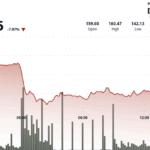Historical Data Suggests Bitcoin’s Dip After Middle East Escalation Is a Buying Opportunity
KEY TAKES:
- Bitcoin (BTC) fell to $102,650 following Israel’s airstrikes on Iran amid rising Middle East tensions.
- Historical data shows Bitcoin has returned an average of 64.6% since 50-day post-geopolitical event catalysts since 2010.
- The current dip could represent a buying opportunity as geopolitical tensions often trigger temporary selling pressure.
Market Reaction and Data Analysis
Bitcoin’s price dropped to $102,650 on Binance Friday after Israel launched airstrikes on Iran, following a period of increasing geopolitical tensions. Concurrently, oil prices rose 5% amid escalating concerns. Historical analysis suggests these fluctuations often create buying opportunities for Bitcoin, despite its reputation as digital gold.
Despite trading near all-time highs, Bitcoin’s Puell Multiple remains notably discounted, pointing to institutional accumulation despite undervalued market conditions.
Bitcoin’s Performance During Geopolitical Crises
According to research from Bitwise Europe, Bitcoin has shown consistent performance during geopolitical crises since 2010. Head of Research, André Dragosch, analyzed data from the top 20 geopolitical risk events, noting Bitcoin’s average 64.6% return within 50 days, with a median gain of 17.3% post-event.
Blockstream CEO, Adam Back, further supported this analysis with data from ten major geopolitical events since 2020. His research shows Bitcoin typically outperforms both gold and the S&P 500 in the weeks following heightened tensions.
Financial Analysis: The Puell Multiple Indicator
CryptoQuant’s data indicates that despite reaching all-time highs, Bitcoin’s Puell Multiple remains near its discount zone, below 1.40. This contradicts price movements that could suggest overvaluation.
“Therefore, the current scenario represents a potential window of opportunity. The combination of a historically high price and still conservative fundamentals reinforces that the upward cycle may only be half over.”
With the effects of the April 2024 halving still influencing miner revenues, analysts suggest institutional demand, rather than sell pressure, is driving market conditions. A Puell Multiple below 1.0 typically indicates accumulation phases.
Glassnode data shows Bitcoin is trading between key short-term cost bases ($97,000-$106,200) that currently align with profit-taking positions. This creates a foundation for recovery from the current dip.
Conclusion
Historical data from multiple research sources suggests that while geopolitical tensions create short-term market reactions, they frequently present buying opportunities for Bitcoin.
Related: Bitcoin mirrors 80% rally setup that preceded 2024 Israel-Iran conflict
Related: Bitcoin price Bollinger Bands ‘failure’ risks end of uptrend at $112K












